MAN7068: Strategic Leadership and Transformation Report Analysis
VerifiedAdded on 2022/01/20
|23
|4868
|52
Report
AI Summary
This report provides a comprehensive analysis of strategic leadership and organizational transformation. It begins with an executive summary that defines leadership and explores its evolving nature, including discussions of leadership power, Belbin's team roles, transformational leadership, and French and Raven's power dynamics. The report then delves into leadership styles, strategies, and development, covering leadership motivation, competencies, and Hofstede's cultural dimensions. Part 2 focuses on the nature of change within organizations, exploring cultural implications, change models, and the role of leadership in managing change. The report concludes with a discussion of strategic leaders' roles and the change management process, drawing on current literature to provide insights into the partnership between strategic management and leadership.
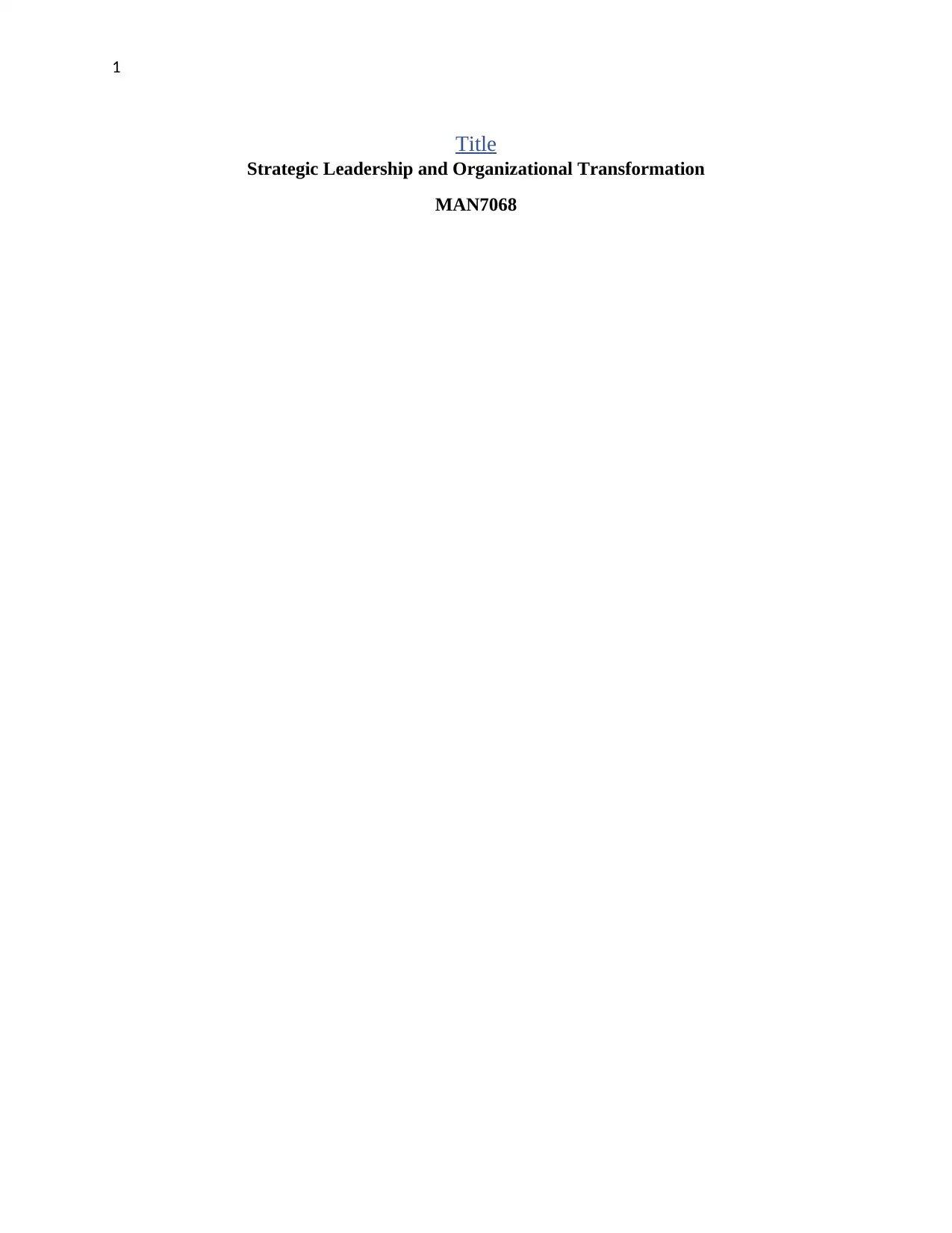
1
Title
Strategic Leadership and Organizational Transformation
MAN7068
Title
Strategic Leadership and Organizational Transformation
MAN7068
Paraphrase This Document
Need a fresh take? Get an instant paraphrase of this document with our AI Paraphraser
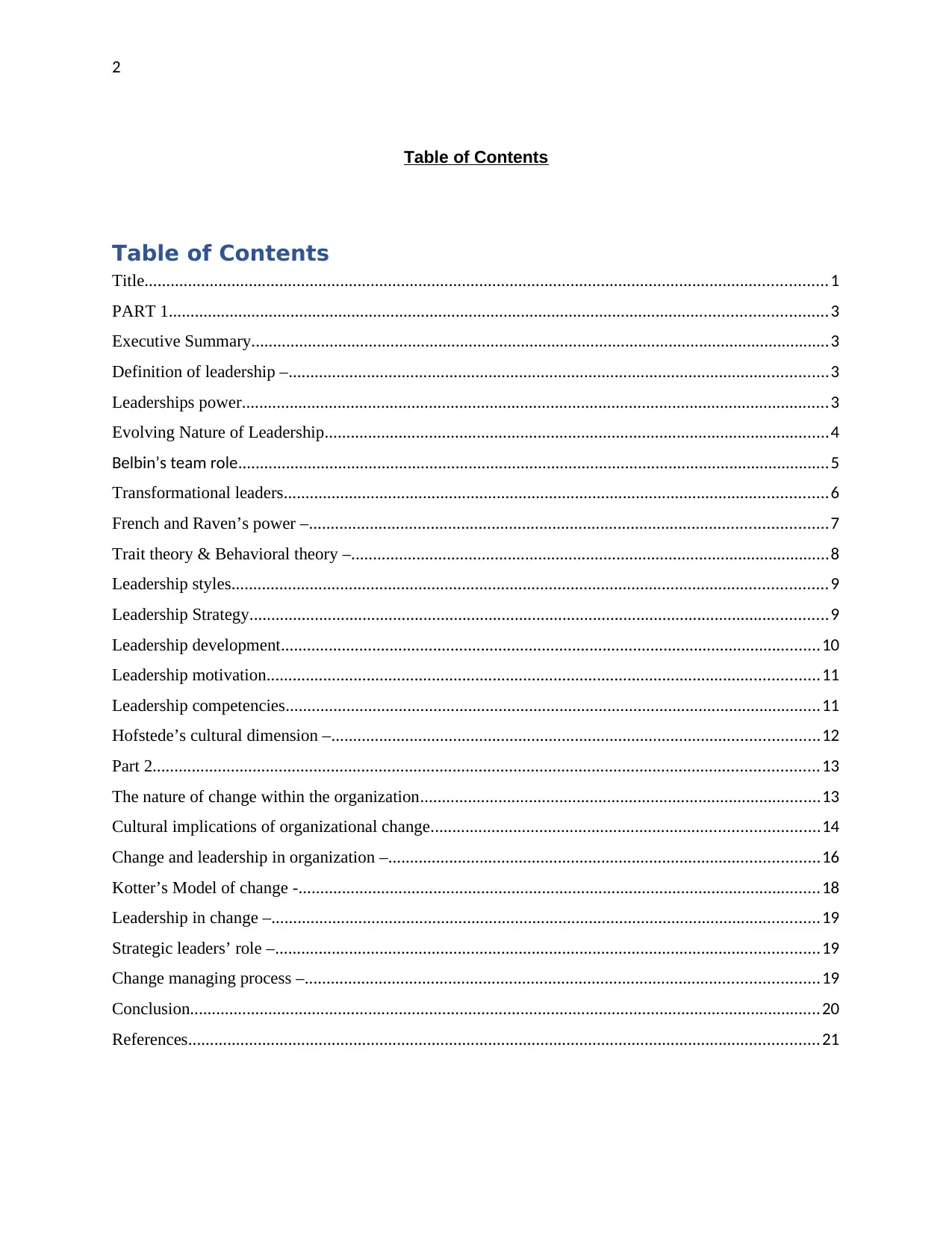
2
Table of Contents
Table of Contents
Title.............................................................................................................................................................1
PART 1.......................................................................................................................................................3
Executive Summary.....................................................................................................................................3
Definition of leadership –............................................................................................................................3
Leaderships power.......................................................................................................................................3
Evolving Nature of Leadership....................................................................................................................4
Belbin’s team role........................................................................................................................................5
Transformational leaders.............................................................................................................................6
French and Raven’s power –.......................................................................................................................7
Trait theory & Behavioral theory –..............................................................................................................8
Leadership styles.........................................................................................................................................9
Leadership Strategy.....................................................................................................................................9
Leadership development............................................................................................................................10
Leadership motivation...............................................................................................................................11
Leadership competencies...........................................................................................................................11
Hofstede’s cultural dimension –................................................................................................................12
Part 2.........................................................................................................................................................13
The nature of change within the organization............................................................................................13
Cultural implications of organizational change.........................................................................................14
Change and leadership in organization –...................................................................................................16
Kotter’s Model of change -........................................................................................................................18
Leadership in change –..............................................................................................................................19
Strategic leaders’ role –.............................................................................................................................19
Change managing process –......................................................................................................................19
Conclusion.................................................................................................................................................20
References.................................................................................................................................................21
Table of Contents
Table of Contents
Title.............................................................................................................................................................1
PART 1.......................................................................................................................................................3
Executive Summary.....................................................................................................................................3
Definition of leadership –............................................................................................................................3
Leaderships power.......................................................................................................................................3
Evolving Nature of Leadership....................................................................................................................4
Belbin’s team role........................................................................................................................................5
Transformational leaders.............................................................................................................................6
French and Raven’s power –.......................................................................................................................7
Trait theory & Behavioral theory –..............................................................................................................8
Leadership styles.........................................................................................................................................9
Leadership Strategy.....................................................................................................................................9
Leadership development............................................................................................................................10
Leadership motivation...............................................................................................................................11
Leadership competencies...........................................................................................................................11
Hofstede’s cultural dimension –................................................................................................................12
Part 2.........................................................................................................................................................13
The nature of change within the organization............................................................................................13
Cultural implications of organizational change.........................................................................................14
Change and leadership in organization –...................................................................................................16
Kotter’s Model of change -........................................................................................................................18
Leadership in change –..............................................................................................................................19
Strategic leaders’ role –.............................................................................................................................19
Change managing process –......................................................................................................................19
Conclusion.................................................................................................................................................20
References.................................................................................................................................................21
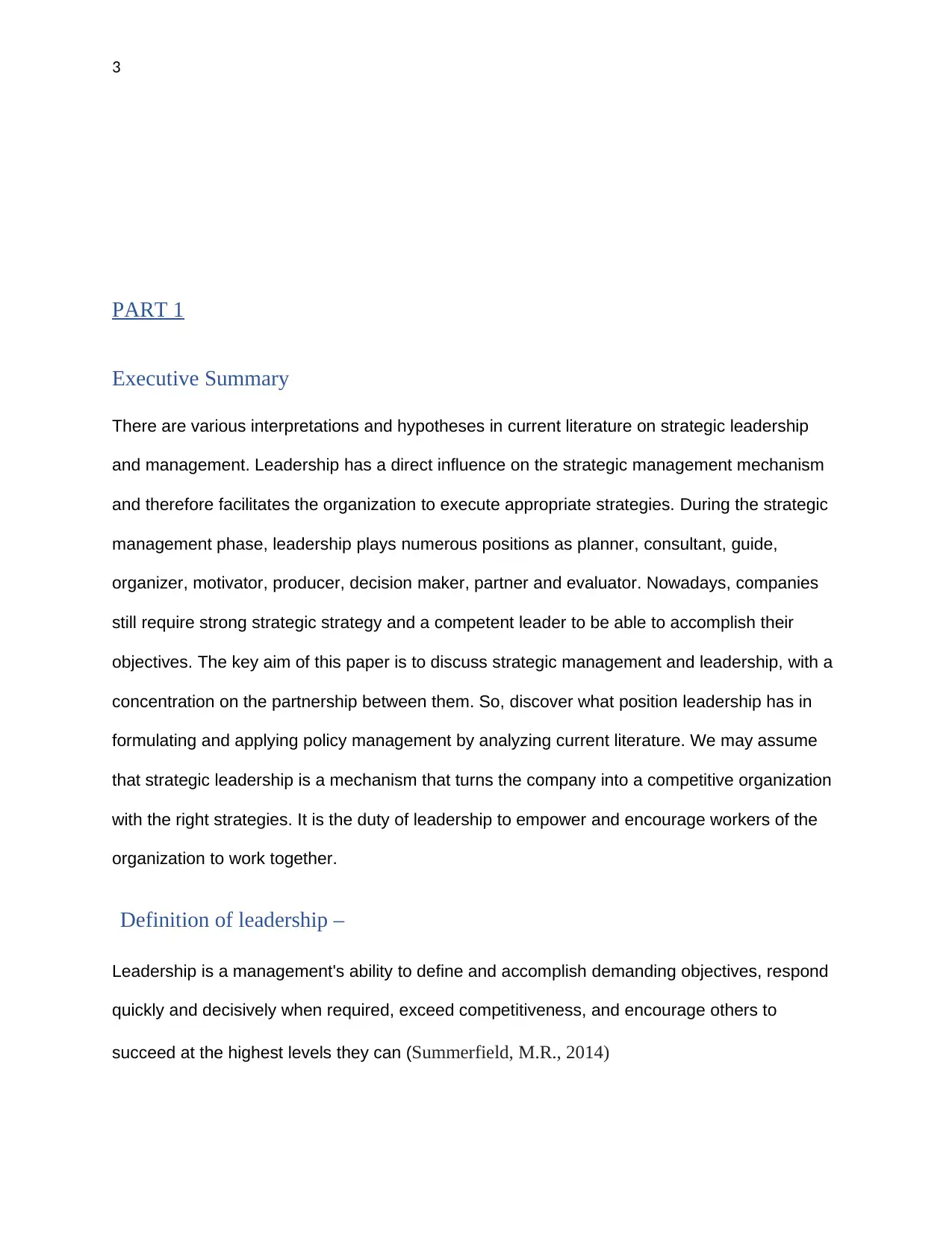
3
PART 1
Executive Summary
There are various interpretations and hypotheses in current literature on strategic leadership
and management. Leadership has a direct influence on the strategic management mechanism
and therefore facilitates the organization to execute appropriate strategies. During the strategic
management phase, leadership plays numerous positions as planner, consultant, guide,
organizer, motivator, producer, decision maker, partner and evaluator. Nowadays, companies
still require strong strategic strategy and a competent leader to be able to accomplish their
objectives. The key aim of this paper is to discuss strategic management and leadership, with a
concentration on the partnership between them. So, discover what position leadership has in
formulating and applying policy management by analyzing current literature. We may assume
that strategic leadership is a mechanism that turns the company into a competitive organization
with the right strategies. It is the duty of leadership to empower and encourage workers of the
organization to work together.
Definition of leadership –
Leadership is a management's ability to define and accomplish demanding objectives, respond
quickly and decisively when required, exceed competitiveness, and encourage others to
succeed at the highest levels they can (Summerfield, M.R., 2014)
PART 1
Executive Summary
There are various interpretations and hypotheses in current literature on strategic leadership
and management. Leadership has a direct influence on the strategic management mechanism
and therefore facilitates the organization to execute appropriate strategies. During the strategic
management phase, leadership plays numerous positions as planner, consultant, guide,
organizer, motivator, producer, decision maker, partner and evaluator. Nowadays, companies
still require strong strategic strategy and a competent leader to be able to accomplish their
objectives. The key aim of this paper is to discuss strategic management and leadership, with a
concentration on the partnership between them. So, discover what position leadership has in
formulating and applying policy management by analyzing current literature. We may assume
that strategic leadership is a mechanism that turns the company into a competitive organization
with the right strategies. It is the duty of leadership to empower and encourage workers of the
organization to work together.
Definition of leadership –
Leadership is a management's ability to define and accomplish demanding objectives, respond
quickly and decisively when required, exceed competitiveness, and encourage others to
succeed at the highest levels they can (Summerfield, M.R., 2014)
⊘ This is a preview!⊘
Do you want full access?
Subscribe today to unlock all pages.

Trusted by 1+ million students worldwide
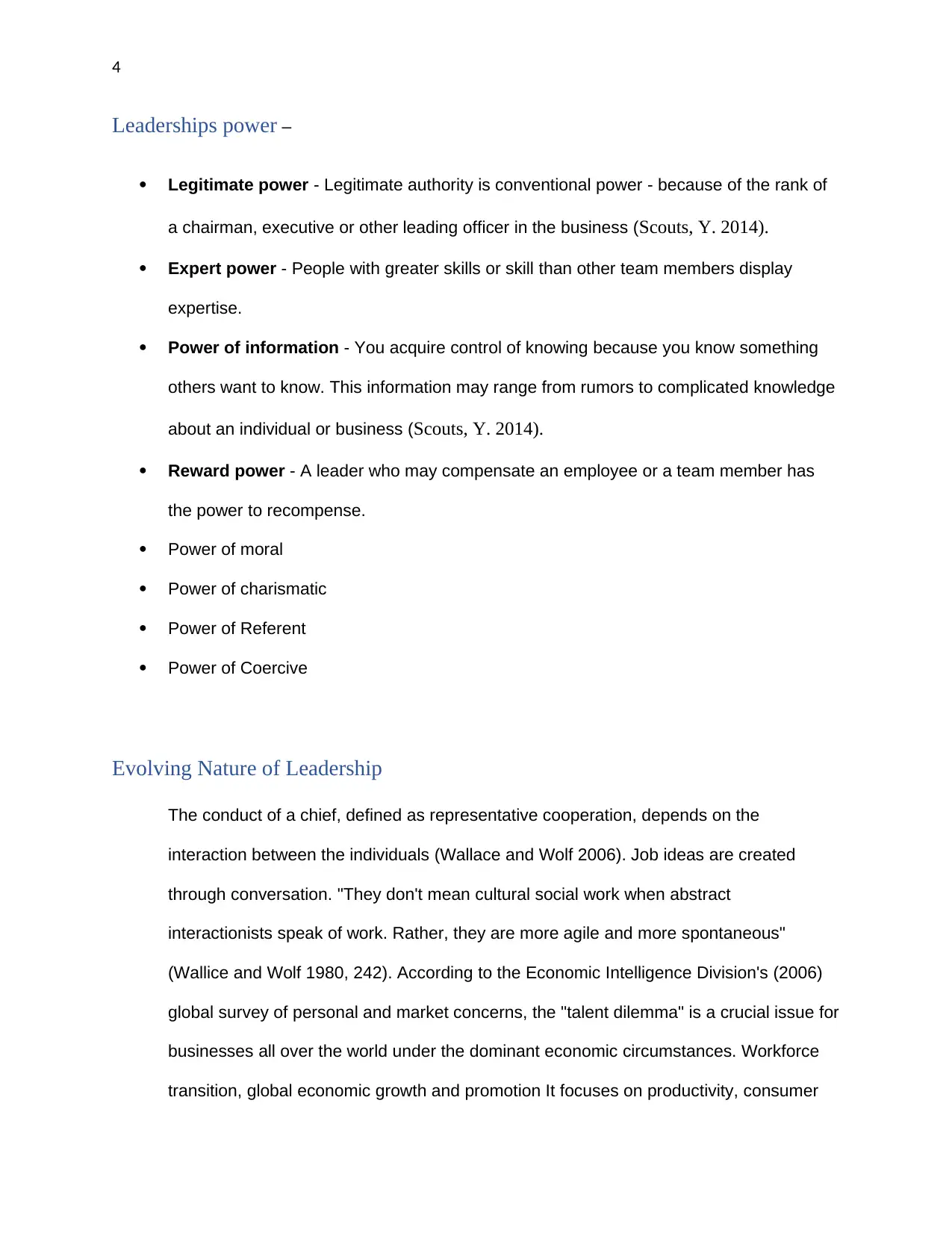
4
Leaderships power –
Legitimate power - Legitimate authority is conventional power - because of the rank of
a chairman, executive or other leading officer in the business (Scouts, Y. 2014).
Expert power - People with greater skills or skill than other team members display
expertise.
Power of information - You acquire control of knowing because you know something
others want to know. This information may range from rumors to complicated knowledge
about an individual or business (Scouts, Y. 2014).
Reward power - A leader who may compensate an employee or a team member has
the power to recompense.
Power of moral
Power of charismatic
Power of Referent
Power of Coercive
Evolving Nature of Leadership
The conduct of a chief, defined as representative cooperation, depends on the
interaction between the individuals (Wallace and Wolf 2006). Job ideas are created
through conversation. "They don't mean cultural social work when abstract
interactionists speak of work. Rather, they are more agile and more spontaneous"
(Wallice and Wolf 1980, 242). According to the Economic Intelligence Division's (2006)
global survey of personal and market concerns, the "talent dilemma" is a crucial issue for
businesses all over the world under the dominant economic circumstances. Workforce
transition, global economic growth and promotion It focuses on productivity, consumer
Leaderships power –
Legitimate power - Legitimate authority is conventional power - because of the rank of
a chairman, executive or other leading officer in the business (Scouts, Y. 2014).
Expert power - People with greater skills or skill than other team members display
expertise.
Power of information - You acquire control of knowing because you know something
others want to know. This information may range from rumors to complicated knowledge
about an individual or business (Scouts, Y. 2014).
Reward power - A leader who may compensate an employee or a team member has
the power to recompense.
Power of moral
Power of charismatic
Power of Referent
Power of Coercive
Evolving Nature of Leadership
The conduct of a chief, defined as representative cooperation, depends on the
interaction between the individuals (Wallace and Wolf 2006). Job ideas are created
through conversation. "They don't mean cultural social work when abstract
interactionists speak of work. Rather, they are more agile and more spontaneous"
(Wallice and Wolf 1980, 242). According to the Economic Intelligence Division's (2006)
global survey of personal and market concerns, the "talent dilemma" is a crucial issue for
businesses all over the world under the dominant economic circumstances. Workforce
transition, global economic growth and promotion It focuses on productivity, consumer
Paraphrase This Document
Need a fresh take? Get an instant paraphrase of this document with our AI Paraphraser
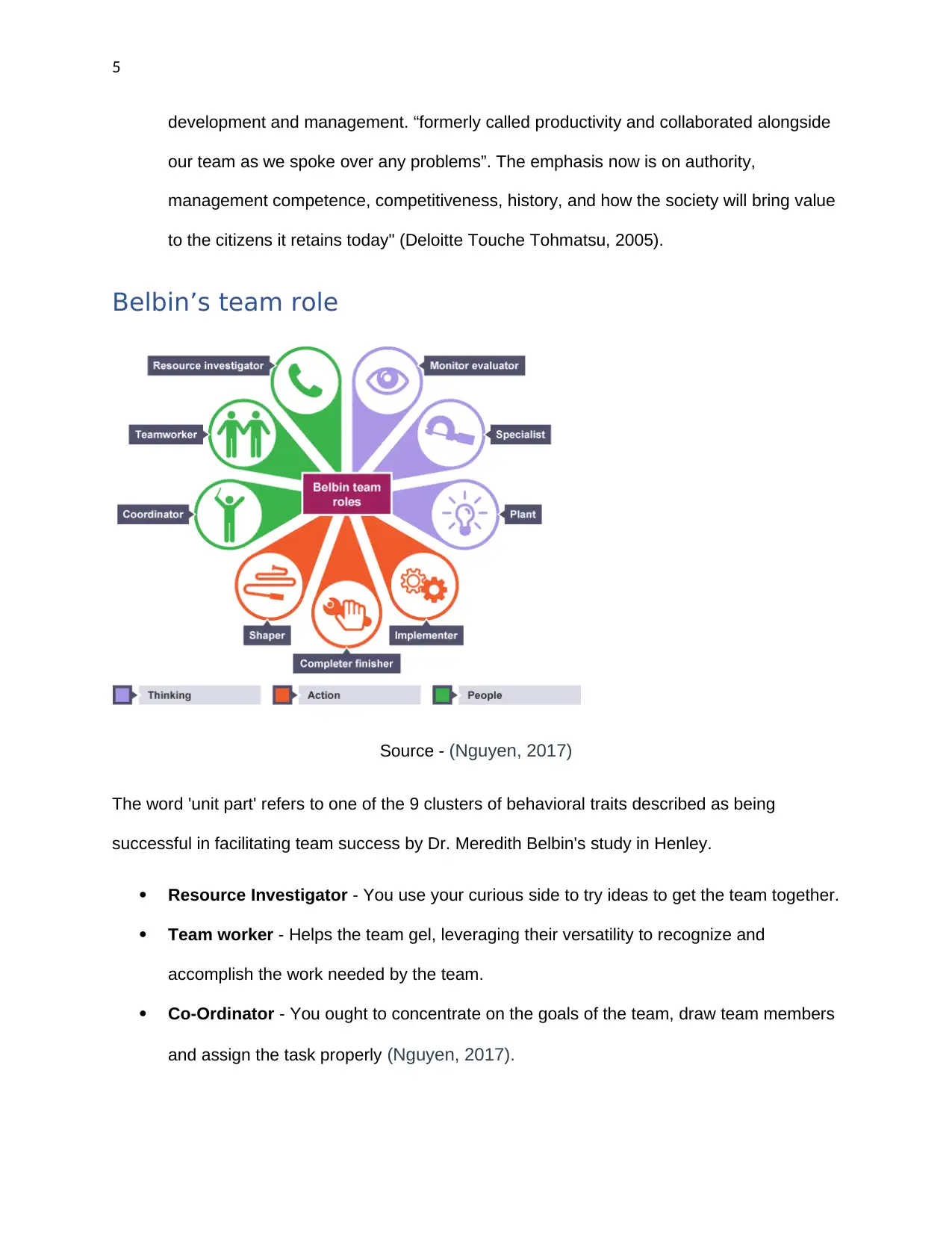
5
development and management. “formerly called productivity and collaborated alongside
our team as we spoke over any problems”. The emphasis now is on authority,
management competence, competitiveness, history, and how the society will bring value
to the citizens it retains today" (Deloitte Touche Tohmatsu, 2005).
Belbin’s team role
Source - (Nguyen, 2017)
The word 'unit part' refers to one of the 9 clusters of behavioral traits described as being
successful in facilitating team success by Dr. Meredith Belbin's study in Henley.
Resource Investigator - You use your curious side to try ideas to get the team together.
Team worker - Helps the team gel, leveraging their versatility to recognize and
accomplish the work needed by the team.
Co-Ordinator - You ought to concentrate on the goals of the team, draw team members
and assign the task properly (Nguyen, 2017).
development and management. “formerly called productivity and collaborated alongside
our team as we spoke over any problems”. The emphasis now is on authority,
management competence, competitiveness, history, and how the society will bring value
to the citizens it retains today" (Deloitte Touche Tohmatsu, 2005).
Belbin’s team role
Source - (Nguyen, 2017)
The word 'unit part' refers to one of the 9 clusters of behavioral traits described as being
successful in facilitating team success by Dr. Meredith Belbin's study in Henley.
Resource Investigator - You use your curious side to try ideas to get the team together.
Team worker - Helps the team gel, leveraging their versatility to recognize and
accomplish the work needed by the team.
Co-Ordinator - You ought to concentrate on the goals of the team, draw team members
and assign the task properly (Nguyen, 2017).
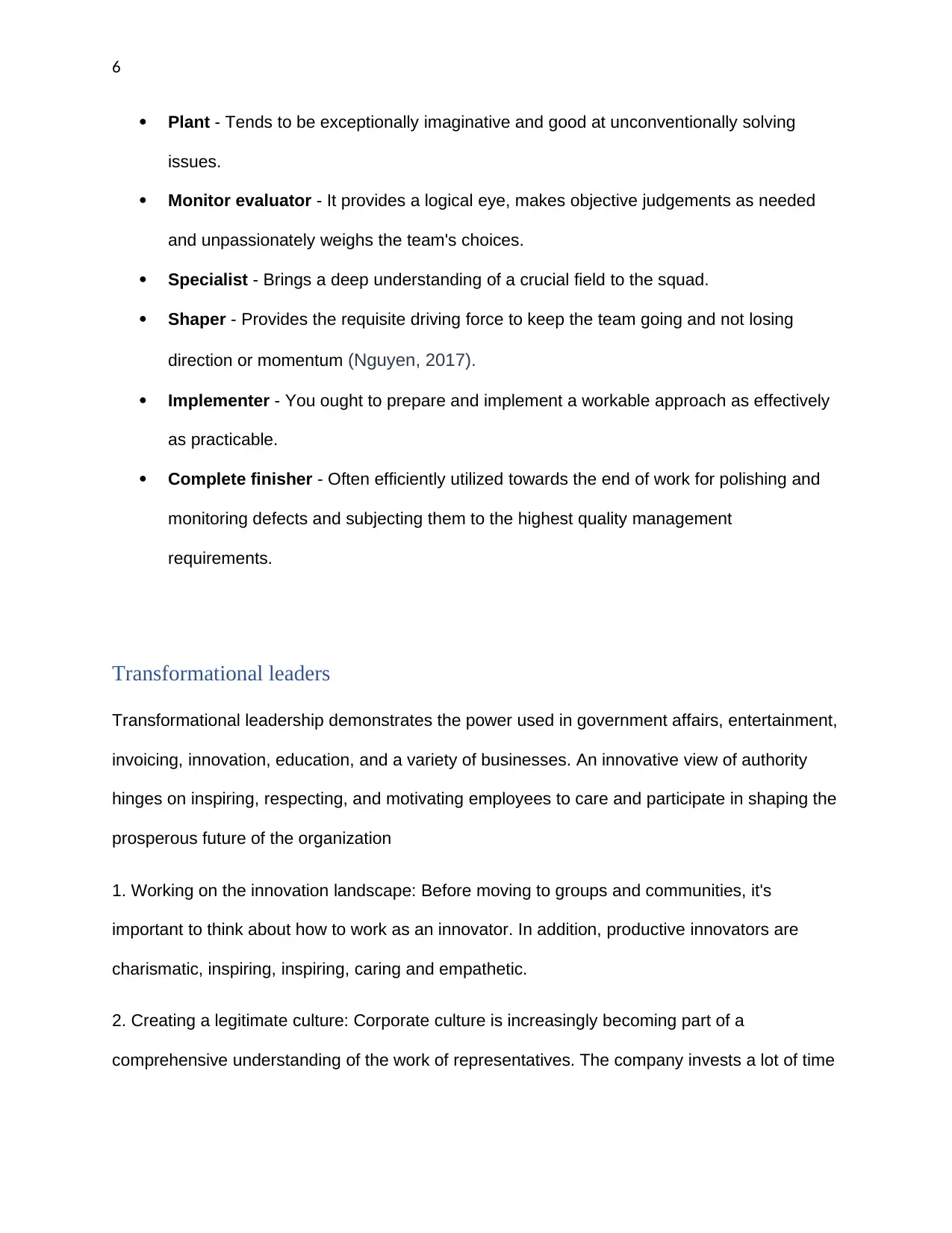
6
Plant - Tends to be exceptionally imaginative and good at unconventionally solving
issues.
Monitor evaluator - It provides a logical eye, makes objective judgements as needed
and unpassionately weighs the team's choices.
Specialist - Brings a deep understanding of a crucial field to the squad.
Shaper - Provides the requisite driving force to keep the team going and not losing
direction or momentum (Nguyen, 2017).
Implementer - You ought to prepare and implement a workable approach as effectively
as practicable.
Complete finisher - Often efficiently utilized towards the end of work for polishing and
monitoring defects and subjecting them to the highest quality management
requirements.
Transformational leaders
Transformational leadership demonstrates the power used in government affairs, entertainment,
invoicing, innovation, education, and a variety of businesses. An innovative view of authority
hinges on inspiring, respecting, and motivating employees to care and participate in shaping the
prosperous future of the organization
1. Working on the innovation landscape: Before moving to groups and communities, it's
important to think about how to work as an innovator. In addition, productive innovators are
charismatic, inspiring, inspiring, caring and empathetic.
2. Creating a legitimate culture: Corporate culture is increasingly becoming part of a
comprehensive understanding of the work of representatives. The company invests a lot of time
Plant - Tends to be exceptionally imaginative and good at unconventionally solving
issues.
Monitor evaluator - It provides a logical eye, makes objective judgements as needed
and unpassionately weighs the team's choices.
Specialist - Brings a deep understanding of a crucial field to the squad.
Shaper - Provides the requisite driving force to keep the team going and not losing
direction or momentum (Nguyen, 2017).
Implementer - You ought to prepare and implement a workable approach as effectively
as practicable.
Complete finisher - Often efficiently utilized towards the end of work for polishing and
monitoring defects and subjecting them to the highest quality management
requirements.
Transformational leaders
Transformational leadership demonstrates the power used in government affairs, entertainment,
invoicing, innovation, education, and a variety of businesses. An innovative view of authority
hinges on inspiring, respecting, and motivating employees to care and participate in shaping the
prosperous future of the organization
1. Working on the innovation landscape: Before moving to groups and communities, it's
important to think about how to work as an innovator. In addition, productive innovators are
charismatic, inspiring, inspiring, caring and empathetic.
2. Creating a legitimate culture: Corporate culture is increasingly becoming part of a
comprehensive understanding of the work of representatives. The company invests a lot of time
⊘ This is a preview!⊘
Do you want full access?
Subscribe today to unlock all pages.

Trusted by 1+ million students worldwide
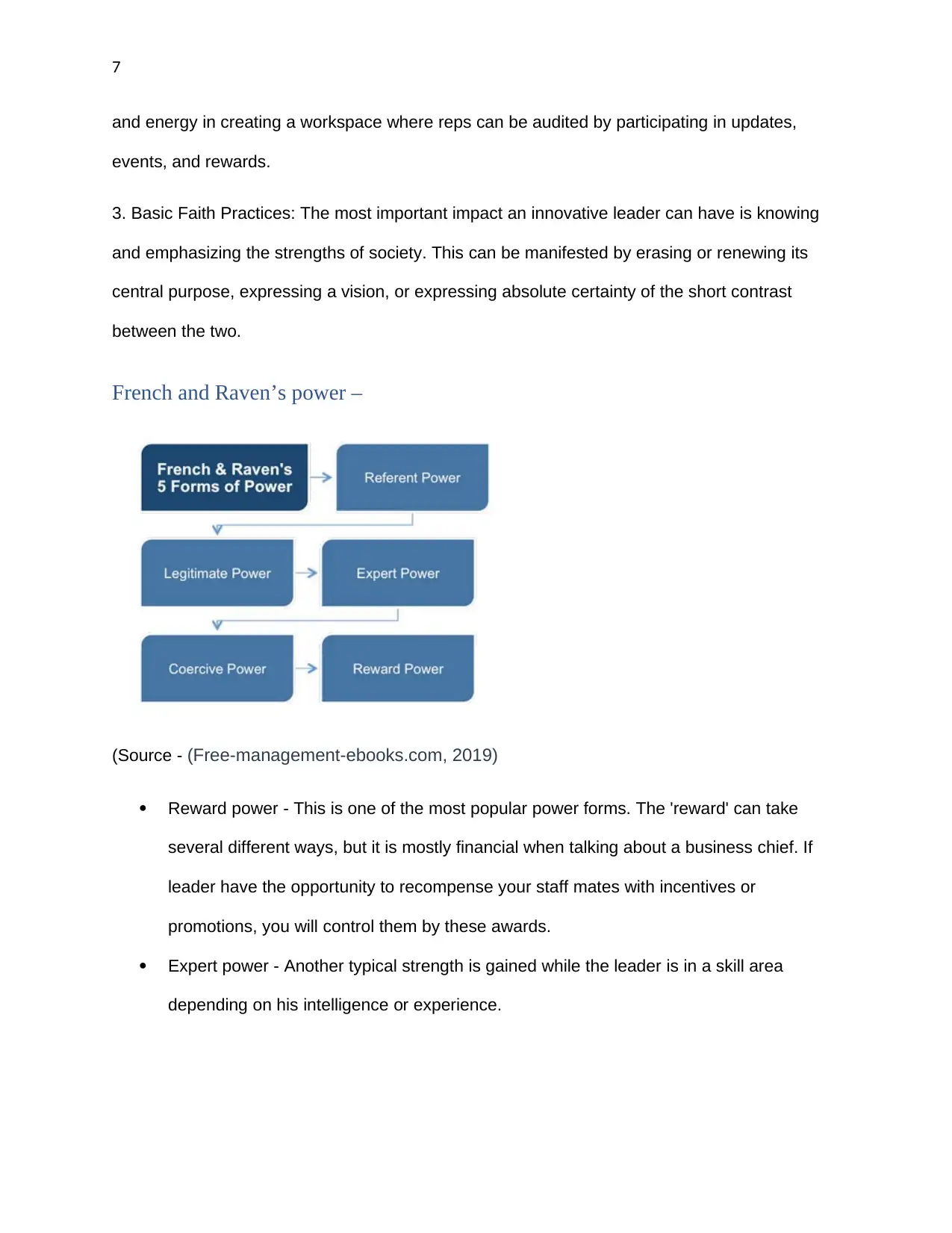
7
and energy in creating a workspace where reps can be audited by participating in updates,
events, and rewards.
3. Basic Faith Practices: The most important impact an innovative leader can have is knowing
and emphasizing the strengths of society. This can be manifested by erasing or renewing its
central purpose, expressing a vision, or expressing absolute certainty of the short contrast
between the two.
French and Raven’s power –
(Source - (Free-management-ebooks.com, 2019)
Reward power - This is one of the most popular power forms. The 'reward' can take
several different ways, but it is mostly financial when talking about a business chief. If
leader have the opportunity to recompense your staff mates with incentives or
promotions, you will control them by these awards.
Expert power - Another typical strength is gained while the leader is in a skill area
depending on his intelligence or experience.
and energy in creating a workspace where reps can be audited by participating in updates,
events, and rewards.
3. Basic Faith Practices: The most important impact an innovative leader can have is knowing
and emphasizing the strengths of society. This can be manifested by erasing or renewing its
central purpose, expressing a vision, or expressing absolute certainty of the short contrast
between the two.
French and Raven’s power –
(Source - (Free-management-ebooks.com, 2019)
Reward power - This is one of the most popular power forms. The 'reward' can take
several different ways, but it is mostly financial when talking about a business chief. If
leader have the opportunity to recompense your staff mates with incentives or
promotions, you will control them by these awards.
Expert power - Another typical strength is gained while the leader is in a skill area
depending on his intelligence or experience.
Paraphrase This Document
Need a fresh take? Get an instant paraphrase of this document with our AI Paraphraser
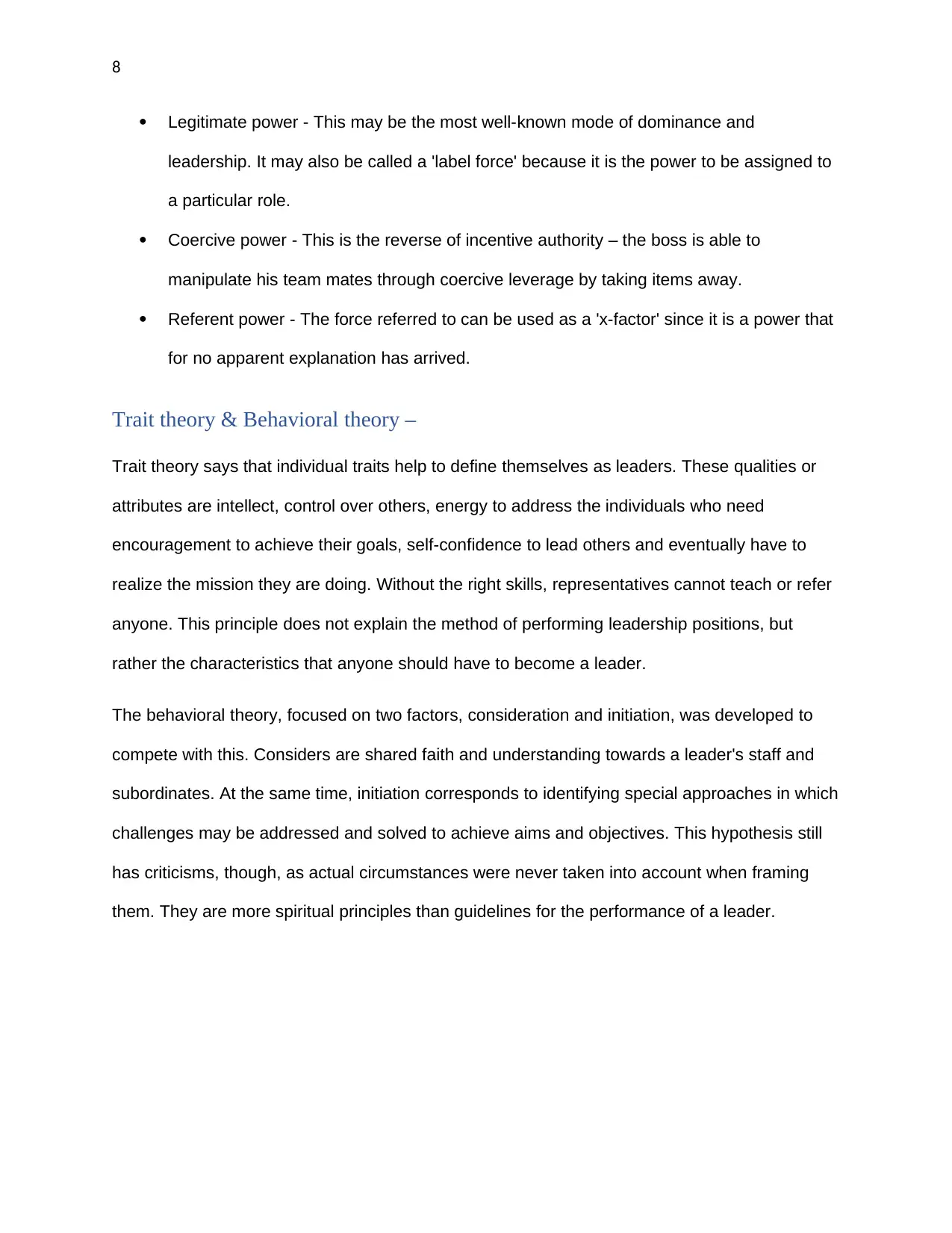
8
Legitimate power - This may be the most well-known mode of dominance and
leadership. It may also be called a 'label force' because it is the power to be assigned to
a particular role.
Coercive power - This is the reverse of incentive authority – the boss is able to
manipulate his team mates through coercive leverage by taking items away.
Referent power - The force referred to can be used as a 'x-factor' since it is a power that
for no apparent explanation has arrived.
Trait theory & Behavioral theory –
Trait theory says that individual traits help to define themselves as leaders. These qualities or
attributes are intellect, control over others, energy to address the individuals who need
encouragement to achieve their goals, self-confidence to lead others and eventually have to
realize the mission they are doing. Without the right skills, representatives cannot teach or refer
anyone. This principle does not explain the method of performing leadership positions, but
rather the characteristics that anyone should have to become a leader.
The behavioral theory, focused on two factors, consideration and initiation, was developed to
compete with this. Considers are shared faith and understanding towards a leader's staff and
subordinates. At the same time, initiation corresponds to identifying special approaches in which
challenges may be addressed and solved to achieve aims and objectives. This hypothesis still
has criticisms, though, as actual circumstances were never taken into account when framing
them. They are more spiritual principles than guidelines for the performance of a leader.
Legitimate power - This may be the most well-known mode of dominance and
leadership. It may also be called a 'label force' because it is the power to be assigned to
a particular role.
Coercive power - This is the reverse of incentive authority – the boss is able to
manipulate his team mates through coercive leverage by taking items away.
Referent power - The force referred to can be used as a 'x-factor' since it is a power that
for no apparent explanation has arrived.
Trait theory & Behavioral theory –
Trait theory says that individual traits help to define themselves as leaders. These qualities or
attributes are intellect, control over others, energy to address the individuals who need
encouragement to achieve their goals, self-confidence to lead others and eventually have to
realize the mission they are doing. Without the right skills, representatives cannot teach or refer
anyone. This principle does not explain the method of performing leadership positions, but
rather the characteristics that anyone should have to become a leader.
The behavioral theory, focused on two factors, consideration and initiation, was developed to
compete with this. Considers are shared faith and understanding towards a leader's staff and
subordinates. At the same time, initiation corresponds to identifying special approaches in which
challenges may be addressed and solved to achieve aims and objectives. This hypothesis still
has criticisms, though, as actual circumstances were never taken into account when framing
them. They are more spiritual principles than guidelines for the performance of a leader.
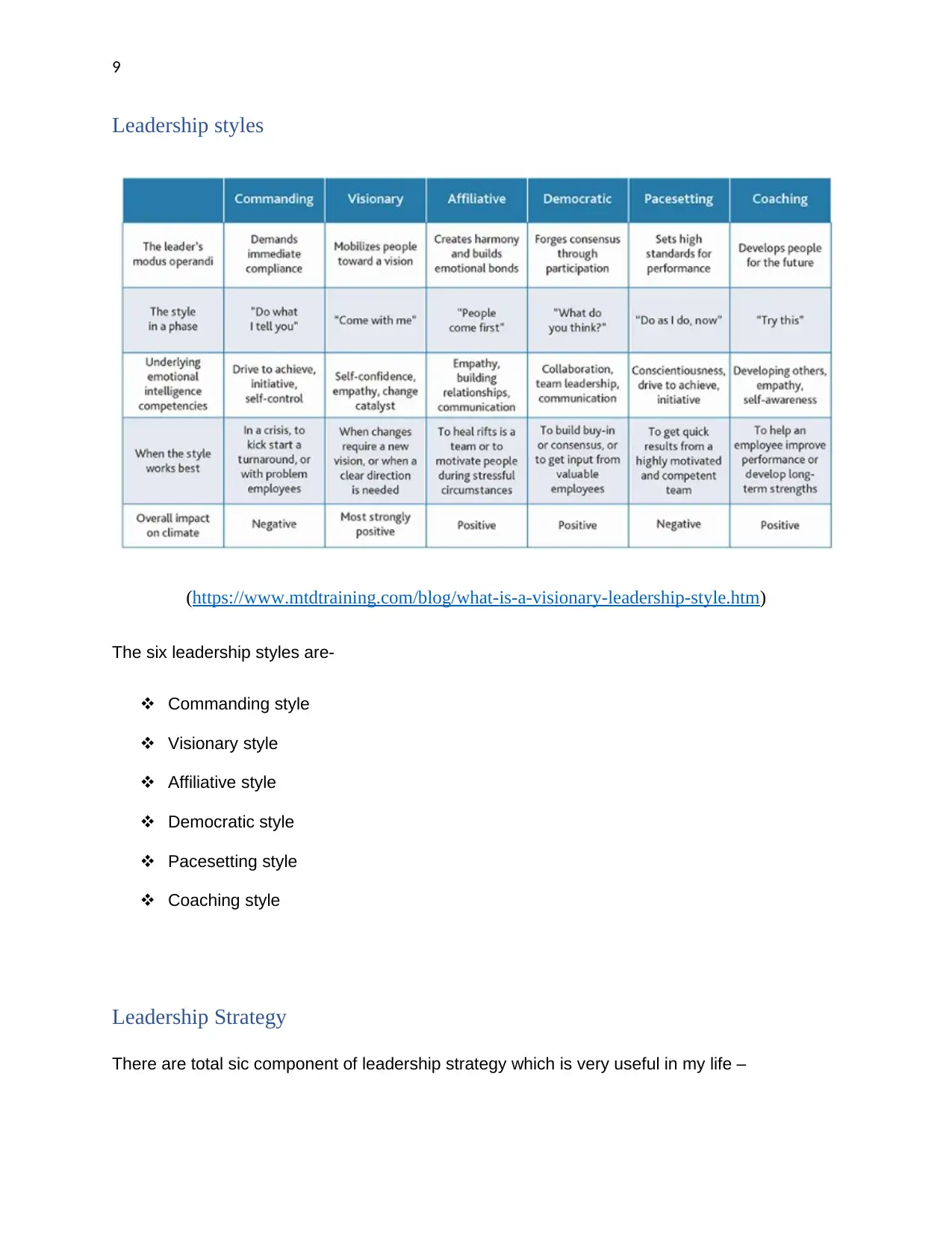
9
Leadership styles
(https://www.mtdtraining.com/blog/what-is-a-visionary-leadership-style.htm)
The six leadership styles are-
Commanding style
Visionary style
Affiliative style
Democratic style
Pacesetting style
Coaching style
Leadership Strategy
There are total sic component of leadership strategy which is very useful in my life –
Leadership styles
(https://www.mtdtraining.com/blog/what-is-a-visionary-leadership-style.htm)
The six leadership styles are-
Commanding style
Visionary style
Affiliative style
Democratic style
Pacesetting style
Coaching style
Leadership Strategy
There are total sic component of leadership strategy which is very useful in my life –
⊘ This is a preview!⊘
Do you want full access?
Subscribe today to unlock all pages.

Trusted by 1+ million students worldwide
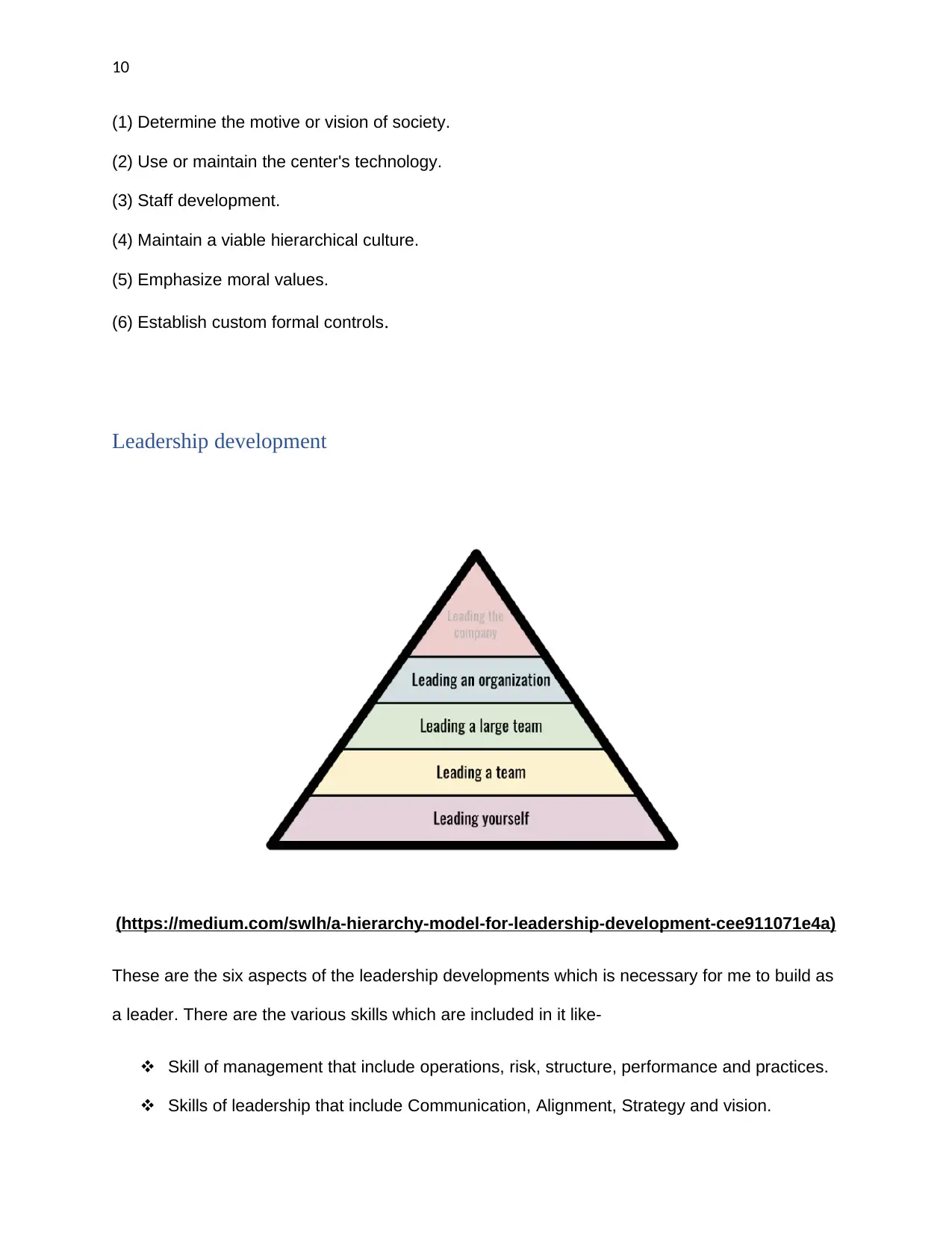
10
(1) Determine the motive or vision of society.
(2) Use or maintain the center's technology.
(3) Staff development.
(4) Maintain a viable hierarchical culture.
(5) Emphasize moral values.
(6) Establish custom formal controls.
Leadership development
(https://medium.com/swlh/a-hierarchy-model-for-leadership-development-cee911071e4a)
These are the six aspects of the leadership developments which is necessary for me to build as
a leader. There are the various skills which are included in it like-
Skill of management that include operations, risk, structure, performance and practices.
Skills of leadership that include Communication, Alignment, Strategy and vision.
(1) Determine the motive or vision of society.
(2) Use or maintain the center's technology.
(3) Staff development.
(4) Maintain a viable hierarchical culture.
(5) Emphasize moral values.
(6) Establish custom formal controls.
Leadership development
(https://medium.com/swlh/a-hierarchy-model-for-leadership-development-cee911071e4a)
These are the six aspects of the leadership developments which is necessary for me to build as
a leader. There are the various skills which are included in it like-
Skill of management that include operations, risk, structure, performance and practices.
Skills of leadership that include Communication, Alignment, Strategy and vision.
Paraphrase This Document
Need a fresh take? Get an instant paraphrase of this document with our AI Paraphraser
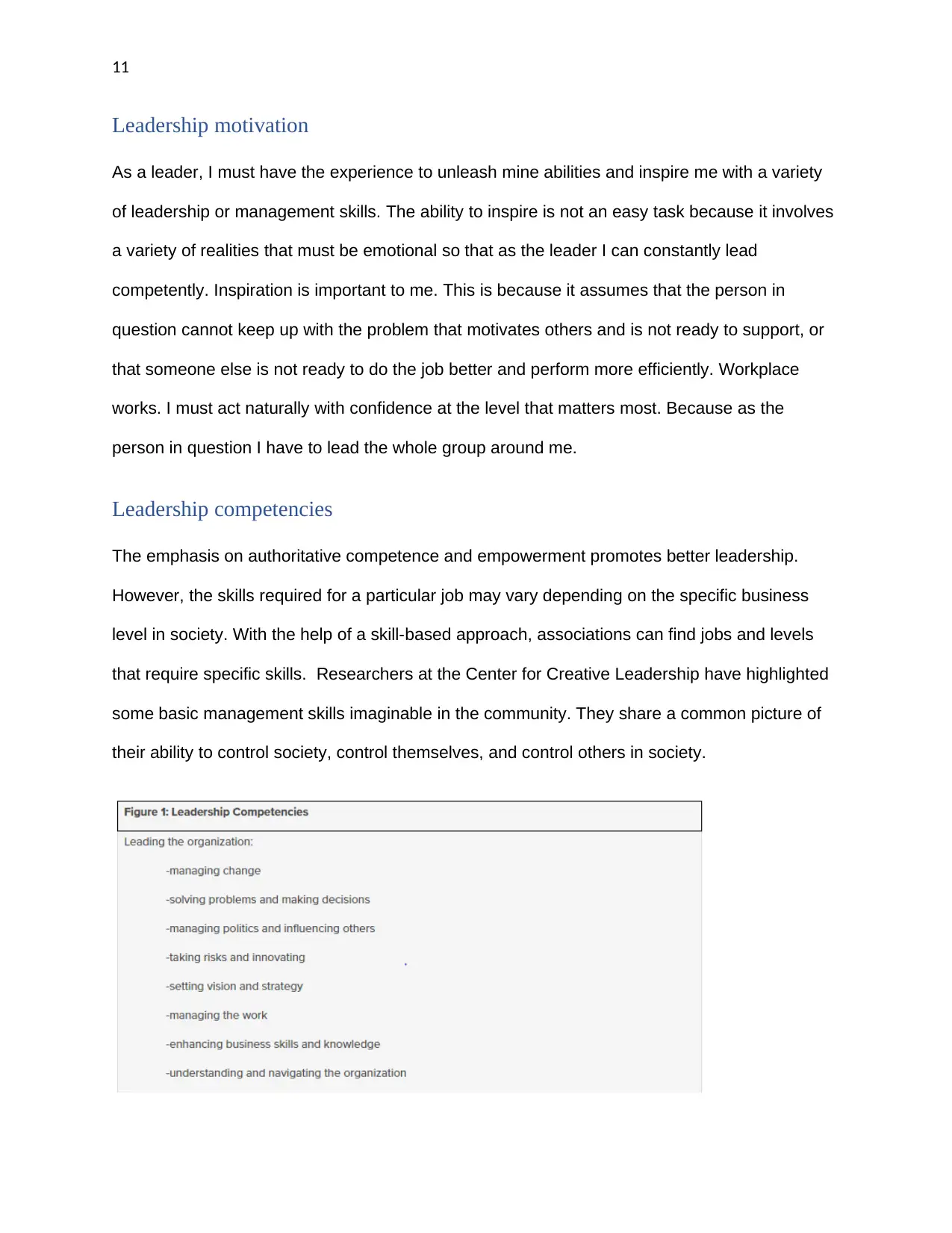
11
Leadership motivation
As a leader, I must have the experience to unleash mine abilities and inspire me with a variety
of leadership or management skills. The ability to inspire is not an easy task because it involves
a variety of realities that must be emotional so that as the leader I can constantly lead
competently. Inspiration is important to me. This is because it assumes that the person in
question cannot keep up with the problem that motivates others and is not ready to support, or
that someone else is not ready to do the job better and perform more efficiently. Workplace
works. I must act naturally with confidence at the level that matters most. Because as the
person in question I have to lead the whole group around me.
Leadership competencies
The emphasis on authoritative competence and empowerment promotes better leadership.
However, the skills required for a particular job may vary depending on the specific business
level in society. With the help of a skill-based approach, associations can find jobs and levels
that require specific skills. Researchers at the Center for Creative Leadership have highlighted
some basic management skills imaginable in the community. They share a common picture of
their ability to control society, control themselves, and control others in society.
Leadership motivation
As a leader, I must have the experience to unleash mine abilities and inspire me with a variety
of leadership or management skills. The ability to inspire is not an easy task because it involves
a variety of realities that must be emotional so that as the leader I can constantly lead
competently. Inspiration is important to me. This is because it assumes that the person in
question cannot keep up with the problem that motivates others and is not ready to support, or
that someone else is not ready to do the job better and perform more efficiently. Workplace
works. I must act naturally with confidence at the level that matters most. Because as the
person in question I have to lead the whole group around me.
Leadership competencies
The emphasis on authoritative competence and empowerment promotes better leadership.
However, the skills required for a particular job may vary depending on the specific business
level in society. With the help of a skill-based approach, associations can find jobs and levels
that require specific skills. Researchers at the Center for Creative Leadership have highlighted
some basic management skills imaginable in the community. They share a common picture of
their ability to control society, control themselves, and control others in society.
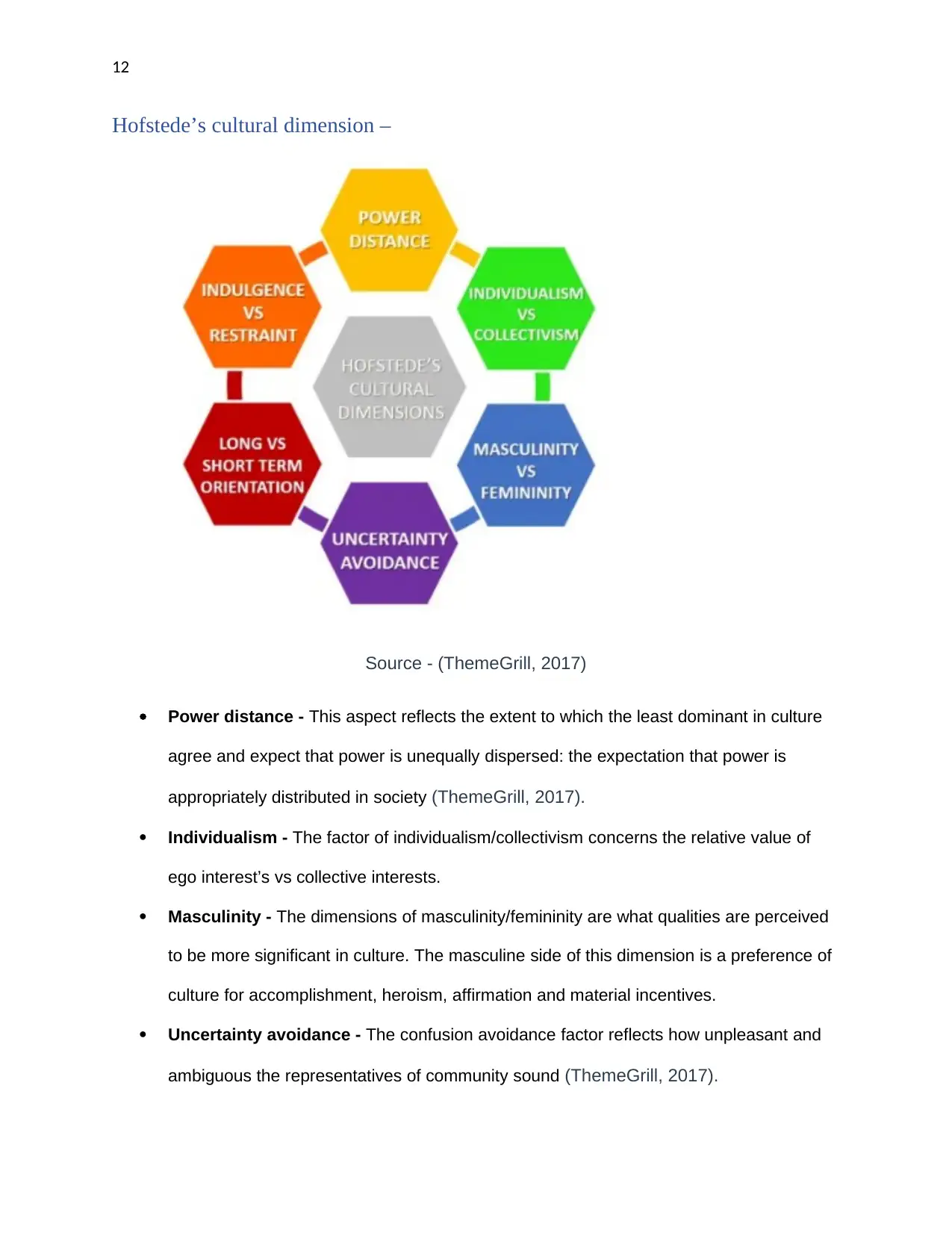
12
Hofstede’s cultural dimension –
Source - (ThemeGrill, 2017)
Power distance - This aspect reflects the extent to which the least dominant in culture
agree and expect that power is unequally dispersed: the expectation that power is
appropriately distributed in society (ThemeGrill, 2017).
Individualism - The factor of individualism/collectivism concerns the relative value of
ego interest’s vs collective interests.
Masculinity - The dimensions of masculinity/femininity are what qualities are perceived
to be more significant in culture. The masculine side of this dimension is a preference of
culture for accomplishment, heroism, affirmation and material incentives.
Uncertainty avoidance - The confusion avoidance factor reflects how unpleasant and
ambiguous the representatives of community sound (ThemeGrill, 2017).
Hofstede’s cultural dimension –
Source - (ThemeGrill, 2017)
Power distance - This aspect reflects the extent to which the least dominant in culture
agree and expect that power is unequally dispersed: the expectation that power is
appropriately distributed in society (ThemeGrill, 2017).
Individualism - The factor of individualism/collectivism concerns the relative value of
ego interest’s vs collective interests.
Masculinity - The dimensions of masculinity/femininity are what qualities are perceived
to be more significant in culture. The masculine side of this dimension is a preference of
culture for accomplishment, heroism, affirmation and material incentives.
Uncertainty avoidance - The confusion avoidance factor reflects how unpleasant and
ambiguous the representatives of community sound (ThemeGrill, 2017).
⊘ This is a preview!⊘
Do you want full access?
Subscribe today to unlock all pages.

Trusted by 1+ million students worldwide
1 out of 23
Related Documents
Your All-in-One AI-Powered Toolkit for Academic Success.
+13062052269
info@desklib.com
Available 24*7 on WhatsApp / Email
![[object Object]](/_next/static/media/star-bottom.7253800d.svg)
Unlock your academic potential
Copyright © 2020–2025 A2Z Services. All Rights Reserved. Developed and managed by ZUCOL.





